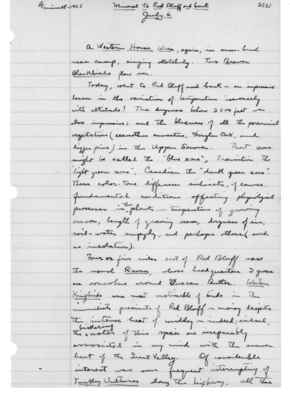Pages That Mention 1925-07-06
1925: Joseph Grinnell's field notes
S2 Page 68
Collector: Grinnell - 1925 Location: Mineral to Red Bluff and back Date: July 6 Page Number: 2521
A western House Wren, again, in snow-brush near camp, singing sketchily. Two Brewer Blackbirds flew over.
Today, went to Red Bluff and back - an impressive lesson in the variation of temperature inversely with altitude! The dryness below 3500 feet was also impressive; and the blueness of all the perennial vegetation (ceanothus cuneatus, Douglas Oak, and digger pine) in the Upper Sonoran. That zone might be called the "blue zone", Transition the "light green zone", Canadian the "dark green zone". These color-tone differences indicate, of course, fundamental conditions affecting physiological processes in ^the plants - temperature of growing season, length of growing season, dryness of air, soil-water supply, and perhaps others (such as insolation).
Four or five miles east of Red Bluff saw the usual Raven, whose headquarters I guess are somewhere around Tuscan Buttes. Western Kingbirds were most noticeable of birds in the immediate precincts of Red Bluff - noisy despite the intense heat of midday - indeed; indeed, the ^bickering notes of this species are inseparable, associated in my mind with the summer heat of the Great Valley. Of considerable interest was our frequent interrupting of Turkey Vultures along the highway, all the
S2 Page 69
Collector: Grinnell - 1925 Location: Red Bluff to ]]Mineral]] Date: July 6 Page Number: 2522
way from the edge of the yellow pines (3300 ft., about) to within the miles of Red Bluff. There is a great deal of "speeding" on this road, stretches of which are straight and finely surfaced. As a result, numbers of Jack Rabbits and Douglas Ground Squirrels are run down; and these "remains" form a quite dependable food source for the Turkey Vultures, which evidently patrol the highway regularly for these victims of the auto. The mammal bodies are, of course, as a rule conspicuous on the roadways, much more so than in the chaparral or on the lava "plains" elsewhere. This is a new manner of draft on the mammalian population; a carefully taken census over a given, average stretch of road-way, would be significant in this connection. There may have been compensation already, however; for example, last winter, I was told by one of the road men that he and others kept steel traps going, for coyotes, ^bob-cats, and foxes, the pelts of which are so valuable. I suppose that means a let-up on the draft of carnivores upon those vegetarians.
Our trip down and back was unfavorable to observing birds along the way. Mostly, when we were stopping, nothing was to be heard; the quiet season has arrived. The hearing of call-notes of Slender-billed Nuthatches
S2 Page 70
Collector: Grinnell - 1925 Location: Mineral Date: July 6 Page Number: 2523
and Western Bluebirds from the very sparse blue oaks on the hot, glaring "plains" above Dale's, where we changed a tire, was notable. Aren't these birds really of "austral" predilection (origin), rather than "boreal" (like the chickadees and creepers)?
July 7 9 a.m. - At camp. The brood of young Chipping Sparrow's near camp left their nest yesterday (see p. 2482); I located two of them nearby, in little yellow pines, this morning; they are bob-tailed, with wisps of natal down still adhering to the contour feather-tips on their heads. Time, in this case, from beginning of incubation to departure of young, approximately 21 days. The parents of this brood are already starting another nest, I think; were getting nest material, ^male singing now and then, and copulated 4 times in one minute, tho immediately afterward were greatly concerned over my too close approach to a young one!
Found another Chipping Sparrow's nest, with 4 half-feathered young which would probably left [sic] for good, had I disturbed them. Rim of nest only 780 mm. above the ground. Nest located in thick^-foliaged slanting spray of ceanothus cordulatus, near edge of clump of same, well sheltered and shaded by dense leafage directly above. There were many young yellow pines round about, but these had been passed up for the low ceanothus in this instance. Also saw full-grown and independent Chipping Sparrows elsewhere, in bush.


